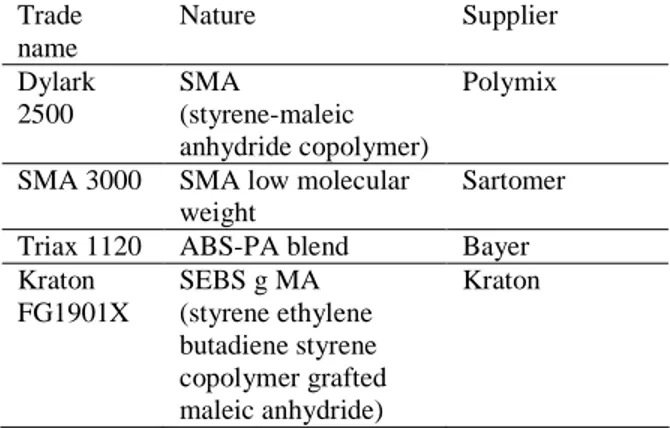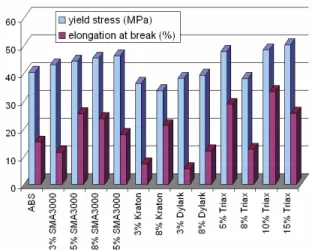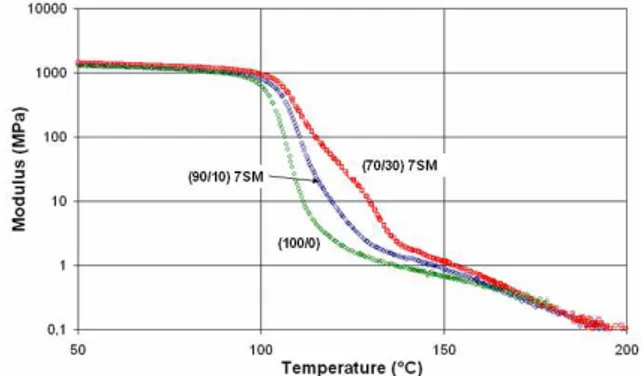Science Arts & Métiers (SAM)
is an open access repository that collects the work of Arts et Métiers Institute of
Technology researchers and makes it freely available over the web where possible.
This is an author-deposited version published in: https://sam.ensam.eu Handle ID: .http://hdl.handle.net/10985/6517
To cite this version :
Alain GUINAULT, Cyrille SOLLOGOUB - Thermomechanical properties of ABS/PA AND ABS/PC blends - 2009
Any correspondence concerning this service should be sent to the repository Administrator : archiveouverte@ensam.eu
____________________
* Corresponding author: 292, rue Saint Martin - 75141 Paris Cedex 03 – France – Tel.: + 33(0)1 40 27 27 85 alain.guinault@cnam.fr
THERMOMECHANICAL PROPERTIES OF ABS/PA AND ABS/PC BLENDS
A.Guinault
1*, C.Sollogoub
11
CNAM – Laboratoire des Matériaux Industriels Polymères
ABSTRACT: The significant increase of Waste Electric and Electronic Equipment (WEEE) has led to an important research in upgrading recycled engineering plastics by means of a blending technique. Classical twin-screw extrusion is compared to a new blending technique, where two polymers are combined together and then flow in several static mixers. This technique allows to obtain different morphologies of compatibilized ABS/PA or ABS/PC blends and the aim of this work is to evaluate the corresponding thermomechanical properties. Experimental results demonstrate in particular that fibrilar morphology is obtained with the new blending technique (only with ABS/PA blends), which could lead to a mechanical enhancement if the adhesion between ABS and PA is optimized.
KEYWORDS: WEEE recycling, mechanical recycling, blending technique, ABS/PA and ABS/PC blends
1
INTRODUCTION
In the last years, electric and electronics industry has become one of the big consumers of engineering plastics, generating simultaneously a big amount of wastes coming from these materials (WEEE). One of the most used plastic in engineering applications is ABS, acrylonitrile – butadiene – styrene copolymer. This polymer, characterized by easy processability, relatively low cost and high impact and chemical resistance, widely appears in parts of computers or TV equipments. The recycling of ABS is rendered difficult because of the oxidative degradation of the butadiene rubber phase during service time, deteriorating its mechanical properties [1].
An interesting way proposed to recycle ABS coming from electrical and electronic equipments is to use blending techniques, in order to combine ABS with polymers presenting a good mechanical and thermal resistance, like PC (Polycarbonate) [1,2] or PA (Polyamide) [3]. Many studies have been reported in the literature on virgin ABS/PC [4,5] or ABS/PA [6,7,8] polymer blends, focusing on the compatibilization question or studying the rheological, mechanical, thermal and morphological properties of these blends. It is even possible to find commercial blends of these materials (see for example CYCOLOY®, an ABS/PC blend commercialized by GE Plastics). Still, from an economical point of view, it would be beneficial to use for these blends, recycled PC or PA, coming from urban wastes. It appears that we can easily find PC from the recycling of Compact Discs and PA from automotive wastes.
The purpose of our study is to investigate the possibilities of preparing blends of recycled ABS with
recycled PC or PA, presenting high thermomechanical performance. In this paper, as a first investigation, we restrict our study on blends with virgin products. A new blending technique is used, where two polymers are combined by coextrusion and then flow through static mixers. A previous study [9] has shown that this blending technique offers the possibility to better control the blend morphology, which has impact on thermomechanical properties. The results obtained on blends prepared with this blending technique are compared with blends produced with an usual twin-screw extruder.
2
MATERIALS
The virgin materials are commercial grades, chosen in order to have the same initial properties as the recycled materials.
Terluran ABS GP 22 (BASF) is a very common product used for computer monitors. Technyl PA C206 (Rhodia) is a rather low molecular mass injection molding grade of polyamide 6 without glass fibers. Lexan PC 121R (GE plastics) is a high fluidity polymer (MW of 33050 g/mol) used to fabricate CD-ROMs.
Table 1 indicates the different compatibilizers suggested by the literature as effective compatibilizers for ABS/PA blends and used in our study. On the other hand, no compatibilizer is needed for ABS/PC blends, since the two polymers used in our study present a rather good affinity.
Table 1: Trade name and nature of the compatibilizers used Trade name Nature Supplier Dylark 2500 SMA (styrene-maleic anhydride copolymer) Polymix
SMA 3000 SMA low molecular weight
Sartomer Triax 1120 ABS-PA blend Bayer Kraton FG1901X SEBS g MA (styrene ethylene butadiene styrene copolymer grafted maleic anhydride) Kraton
2.1 BLENDS AND SAMPLE PREPARATION 2.1.1 Drying
Prior to each processing step, all the materials were vacuum dried in an oven to remove absorbed water. Table 2 summarizes the drying conditions used for the materials.
Table 2: Drying conditions used for the materials
Material Drying temperature (°C) Drying time (hours) ABS 70 4 PA 80 4 PC 100 12 2.1.2 Blending
Two processes were used to prepare blends: a classical twin-screw extruder (TSE) and a new blending technique named coextrusion mixing method (CM method), described in [9]. In this technique, two polymers are combined together by coextrusion and flow through several static mixers (SM). The static mixers used in this work consist of crossed bars at 45° angle with the axis of the pipe. Depending on the number of the static mixers (2 to 7), different morphologies for the blend can be obtained.
In the TSE, where screws have the configuration for best mixing efficiency, 30% by weight of PA is added to 70% of ABS. In 100 parts of the ABS/PA (70/30) blend, we introduce the compatibilizers listed table 1. Different final blends with 3, 5, 8, 10 or 15 parts of the compatibilizers were prepared at 210°C, in order to limit thermal degradation of the materials.
With the CM method, blend composition can be varied by adjusting the screw speeds of the two extruders. Two blend compositions were produced: ABS/PA (70/30) and ABS/PA (90/10). The compatibilizer was incorporated in the central extruder, with ABS. This technique allows also to use different temperature for the two extruders: while the temperature for the principal extruder (ABS) was set to 210°C, it was changed for the lateral extruder,
according to the polymer extruded (235°C for PA and 300°C for PC).
2.1.3 Test specimen preparation
Blend extrudates were pelletized and then dried at 70°C during 4 hours to eliminate moisture. Dried pellets were then injection moulded at 220°C, using an ANKER molding machine, in order to obtain normalized test specimens and to measure mechanical properties according to ISO 527. This rather low injection temperature was chosen in order to avoid any modification of the initial blend morphology of the pellets.
2.2 SAMPLE CHARACTERIZATION 2.2.1 Tensile tests
Tensile properties were measured using a universal tensile machine (Instron model 4507). The yield stress and elongation at break were characterized at a cross-head speed of 5 mm/min.
2.2.2 Dynamical Mechanical Thermal Analysis Dynamical Mechanical Thermal Analysis was carried out on small bar samples using a Triton Tritech® Rheometer, working in dynamic tensile mode. The oscillating frequency was set to 1 Hz and the temperature was varied from 25°C to 200°C at 2°C/min. 2.2.3 Morphology
Injected polymer specimens were cryofractured and the fracture surface was coated with a thin layer of gold. The morphology of both ABS/PA and ABS/PC blends was investigated, in parallel and transverse directions to the injection flow, using Scanning Electron Microscopy (Cambridge Instruments - Stereoscan 240).
3
RESULTS AND DISCUSSION
3.1 ABS/PA BLENDS3.1.1 Blends produced with a twin-screw extrusion (TSE)
Figure 1 shows the yield stress and the elongation at break for the different blends produced with TSE and the compatibilizers. It appears that mechanical properties of ABS can be enhanced, if choosing the proper compatibilizer at the right proportion.
SMA 3000 and Triax 1120 seem to be the more efficient compatibilizers, leading to an increase of the yield stress (up to 20%) and the elongation at break (up to 50%). The amount of compatibilizer appears to be an important parameter to optimize. For example, the best increase of the elongation at break was obtained when adding 5 to 10 parts of compatibilizer in the blend.
Figure 1: Yield stress and elongation at break of the compatibilized ABS/PA (70/30) blends
As expected, the micrographs exhibit dispersed nodular particle/matrix structures. The compatibilizing effect of the SMA3000 is illustrated by the small PA-domain size, with a cross-section diameter around 1 µ m (see figure 2), as well as by a PA nodular structure well bonded to the ABS matrix.
Figure 2: SEM micrograph of ABS/PA/SMA3000 (70/30/3)
3.1.2 Blends produced with the coextrusion mixing method (CM method)
ABS/PA (70/30) and ABS/PA (90/10) blends were produced using 2, 4 and 7 static mixers. For cost effectiveness reasons, SMA was preferred to Triax as compatibilizer and following the results shown figure 1, 5 parts of SMA were added in the blends. The results of the mechanical evaluation are summarized in Table 3. It is to notice that a lack of adhesion between ABS and PA was observed, leading to a decohesion of the blend during the pelletization. This decohesion was more pronounced as the number of static mixers was decreased.
Despite this obvious lack of adhesion, an enhancement of the mechanical properties of the blend is observed when adding 30% of PA. This enhancement seems less pronounced with 2 SM, but this is certainly due to the adhesion problem, observed to be more severe for 2 SM.
Table 3: Mechanical properties obtained with the
different ABS/PA blends produced with several static mixers (standard deviations are given in brackets)
ABS/PA (90/10) ABS/PA (70/30) Number of static mixers Yield stress (MPa) Elongation at break (%) Yield stress (MPa) Elongation at break (%) 2 No yield 3.7 (0.3) 40.1 (1.1) 14.6 (7.7) 4 No yield 2.4 (0.7) 43.1 (0.9) 8.6 (1.5) 7 40.3 (0.3) 4.6 (0.6) 43.4 (0.2) 10.9 (3.8)
Similar conclusions can be observed on the DMTA curves shown figure 3. These curves point out that thermomechanical behaviour of the ABS/PA blends was improved when the PA amount in the blend is increased, as indicated by a smaller decrease of the elastic modulus after the glass transition. A slight improvement is observed as the number of static mixers is decreased.
Figure 3: DMTA curves of ABS and ABS/PA blends obtained with the two methods, TSE and CM (2 and 7 SM).
These results could be explained by the morphology of the blends, presented figure 4. These micrographs show clearly that the morphology obtained with the CM method is fibrilar, whatever the number of static mixers. But the fibrils appear to be thinner and shorter as the number of static mixers increases.
Figure 4: SEM micrographs of ABS/PA/SMA3000 (70/30/5) obtained with CM method (2 and 7 SM) Nevertheless, the mechanical improvement expected with this fibrilar morphology is certainly minimized
because of the poor adhesion between ABS and PA, as indicated by the observed decohesion. This problem of lack of adhesion is more sensitive with fibrilar morphologies obtained with CM method than with nodular morphologies obtained with TSE. It can be assumed that an improved affinity between these two polymers would lead to a better thermomechanical behaviour than the one obtained with TSE.
3.2 APPLICATION OF THE CM METHOD TO THE ABS/PC BLENDS
A preliminary work performed on the TSE has shown that no compatibilization is needed for ABS/PC blends. The CM method was thus applied to this blend, without any compatibilizer and using 7 static mixers. The obtained mechanical properties are summarized table 4 and show that blending ABS with PC has no or little effect on the yield stress, but increases significantly (up to 60%) the elongation at break. This improvement is certainly due to the better compatibility of PC with ABS. Still, the amount of added PC does not have any impact on the mechanical properties.
Table 4: Mechanical properties obtained with the
different ABS/PC blends (standard deviations are given in brackets) ABS ABS/PC (90/10) ABS/PC (70/30) Yield stress (MPa) 40 (1) 39.9 (0.9) 41.5 (0.2) Elongation at break (%) 10 (3) 27.7 (8.7) 22.2 (3.1)
DMTA curves, shown figure 5, indicate no improvement of the thermomechanical behaviour as well as no effect of the blend composition (except on the position of the glass transition temperatures).
Figure 5: DMTA curves of ABS and ABS/PC blends obtained with the CM method (7 SM)
This result could be explained firstly by the fact that PC is an amorphous polymer with a glass transition temperature close to the ABS’ one. Secondly, the observation of the corresponding micrographs reveals a nodular morphology and not a fibrilar one.
4
CONCLUSIONS
This study has shown that ABS/PA and ABS/PC blends can be prepared using a new blending technique, combining coextrusion and flow through static mixers. The obtained blends display mechanical performances (yield stress and elongation at break) similar to those obtained with the classical TSE process. This new method allows, in some cases, to generate fibrilar morphology supposed to improve the mechanical performance comparatively to a nodular morphology. In the case of the ABS/PA blends, even if the fibrilar morphology was obtained, the mechanical enhancement was not observed, certainly due to a lack of interfacial adhesion between ABS and PA. More generally, it appears that this CM method could be of great interest for the recycling of ABS waste, presenting the advantage to provide manufactured extruded products in a single step, contrary to the classical TSE method.
ACKNOWLEDGEMENT
The authors would like to acknowledge the financial support of the ADEME.
REFERENCES
[1] L. Xiadong, H. Bertilsson. Recycling of ABS and ABS/PC Blends. J. Appl. Polym. Sci., 74:510-515, 1999.
[2] R. Balart, J. Lopez, D. Garcia, M. Dolores Salvador. Recycling of ABS and PC from electrical and electronic waste. Effect of miscibility and previous degradation on final performance of industrial blends. Eur. Polym. Jour., 41:2150-2160, 2005. [3] X. Liu, A. Boldizar, M. Rigdahl, H. Bertilsson.
Recycling of blends of Acrylonitrile-Butadiene-Styrene (ABS) and Polyamide. J. Appl. Polym. Sci., 74:510-515, 1999.
[4] B.I. Chaudhry, E.Hage, L.A.Pessan. Effect of processing conditions on the phase morphology of PC/ABS Polymer blends. J. Appl. Polym. Sci., 67:1605-1613, 1998.
[5] M.MK. Khan, R.F. Liang, R.K. Gupta, S. Agarwal. Rheological and mechanical properties of ABS/PC blends. Korea-Australia Rheol. Jour., 17:1-7, 2005. [6] S. Phil Jang, D. Kim. Thermal, mechanical, and
diffusional properties of Nylon 6/ABS Polymer blends: compatibilizer effect. Polym. Eng. Sci., 40:1635-1642, 2000.
[7] R.A. Kudva, H. Keskkula, D.R. Paul. Properties of compatibilized Nylon 6/ABS blends. Part II. Effects of compatibilizer type and processing history. Polymer, 41:239-258, 2000.
[8] E.M. Araujo, E. Hage Jr., A.J.F. Carvalho. Thermal properties of nylon 6/ABS polymer blends: compatibilizer effect. Jour. of Mat. Sci., 39:1173-1178, 2004.
[9] C. Sollogoub, A. Guinault, M. Pedros. Evolution of coextruded structures in static mixers. In AIP Conference Proceedings, 10th Esaform Conference on material Forming, pages. 975-979, 2007.


